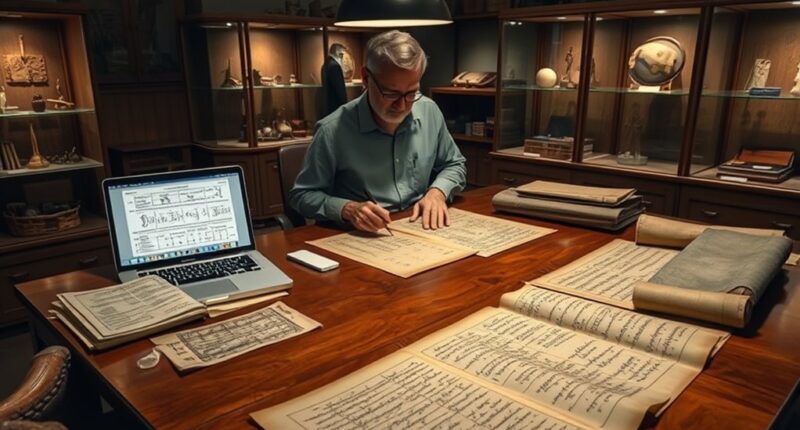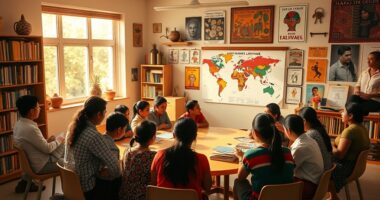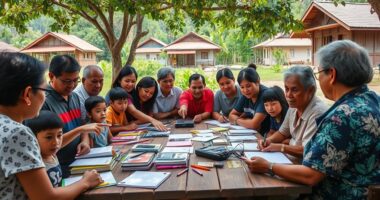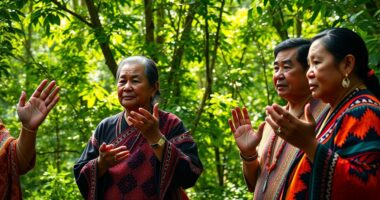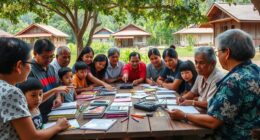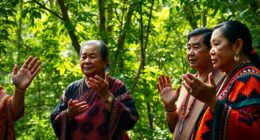Linguists reconstruct extinct languages by analyzing existing dialects, recordings, and written texts, often preserved by communities or descendants. Modern technology helps fill gaps through digital archives, audio recordings, and comparison software, revealing pronunciation and grammatical features. Community involvement adds authentic insights, making revival efforts more effective. Thanks to these methods, languages once thought lost can be brought back to life, offering a glimpse into the past—keep exploring to discover how these processes work in detail.
Key Takeaways
- Linguists analyze surviving dialects and oral histories to reconstruct pronunciation, vocabulary, and grammatical structures of extinct languages.
- Technology such as audio recordings and digital archives helps document and compare linguistic features for accurate reconstruction.
- Community involvement provides essential insights and cultural context, enhancing the authenticity of revived language forms.
- Comparative studies of related languages and dialects reveal historical evolution and fill gaps in scarce historical records.
- Educational resources and digital tools enable the dissemination and teaching of reconstructed languages to ensure their preservation.

Many extinct languages are experiencing a resurgence thanks to dedicated efforts and modern technology. You might find yourself surprised at how much can be achieved through meticulous language documentation. When linguists set out to revive a language, they begin by gathering everything available—historic texts, recordings, and oral histories. This process, known as language documentation, is essential because it preserves the language’s structure, vocabulary, and pronunciation for future use. Without thorough documentation, efforts to reconstruct a language become much more difficult, if not impossible. Modern dialects also play a significant role. Often, dialects of a language survive in isolated communities or among elders, acting as living repositories of linguistic features that have otherwise vanished. By studying these dialects, linguists can piece together the language’s historical form, which helps in creating a more complete reconstruction.
You may not realize how technology accelerates this process. Digital archives allow researchers worldwide to access and analyze language data quickly and collaboratively. Audio recordings help capture pronunciation nuances that written texts alone can’t convey, and software tools assist in comparing dialectal variations. These advancements enable linguists to fill in gaps left by scarce historical records, making the reconstructed language more accurate and authentic. For example, once a language’s phonetics and grammar are reconstructed from various dialects and documented sources, you can see how the language might have sounded and functioned centuries ago. This reconstruction is essential for teaching the language to new generations and integrating it into cultural practices.
As you explore revival projects, you’ll notice the importance of community involvement. Native speakers and descendants often act as living sources, providing insights into pronunciation, idioms, and everyday usage. Their participation not only helps refine the reconstructed language but also fosters cultural pride and continuity. Modern technology also allows for creating educational resources, like apps and online courses, making learning accessible to a broader audience. This accessibility is key to sustaining the revived language over time. Ultimately, through diligent language documentation, leveraging modern dialects, and technological innovation, linguists can breathe new life into languages once thought lost forever. Your role as a learner or supporter is essential—each effort helps keep these ancient words alive for future generations to explore, understand, and cherish.
Frequently Asked Questions
Can Extinct Languages Be Fully Restored to Everyday Use?
Extinct languages can’t typically be fully restored to everyday use, but you can revive them for cultural preservation and linguistic authenticity. While some vocabulary and grammar are reconstructed through historical records, achieving complete fluency is challenging. You might use these languages in ceremonial or educational settings, helping keep their legacy alive. Ultimately, revival efforts focus on honoring cultural heritage, even if full daily communication remains difficult.
How Long Does It Typically Take to Revive an Extinct Language?
Reviving an extinct language usually takes decades, depending on linguistic timelines and the complexity of revival challenges. You’ll find that it involves extensive research, creating educational resources, and community engagement. The process can be slow because you need to rebuild vocabulary, grammar, and pronunciation from historical records. While some languages have seen success within a few generations, others require persistent effort over many years to become part of daily life again.
What Role Do Modern Technology Tools Play in Language Reconstruction?
Modern technology tools like digital archives and artificial intelligence play a vital role in language reconstruction. You can access vast collections of historical texts and recordings through digital archives, making it easier to analyze and compare linguistic data. Artificial intelligence helps identify patterns and reconstruct pronunciation or grammar rules, speeding up the process. These tools empower you to revive extinct languages more efficiently and accurately, bridging the past with the present.
Are There Ethical Concerns in Reviving Extinct Languages?
You should consider ethical concerns like cultural appropriation and linguistic ownership before reviving an extinct language. If you overlook these issues, you risk disrespecting communities and misrepresenting identities. Respectful revival requires collaboration, consent, and careful cultural consideration. By honoring the original speakers’ rights and traditions, you ensure your efforts support cultural preservation without crossing boundaries or causing harm. Always prioritize ethics in your linguistic revival endeavors.
How Do Communities React to Efforts of Language Revival?
You see communities often react with enthusiasm when they’re involved in language revival efforts. Community engagement plays a vital role, fostering pride and strengthening cultural identity. Some members might feel nostalgic or empowered, embracing their heritage anew. However, others could be skeptical or hesitant if they see revival as superficial or misaligned with their needs. Overall, active participation helps guarantee the revival aligns with community values and enhances cultural resilience.
Conclusion
Reviving extinct languages is like bringing a forgotten melody back to life, filling the air with echoes of the past. As a linguist, you hold the power to reconnect communities with their history and culture, breathing new significance into words once thought lost forever. Every reconstructed phrase is a bridge across time, reminding us that language is a living, breathing thing—capable of uniting us and shaping our future, just like a song that never truly fades away.
Mary is a passionate writer who brings creativity and a fresh perspective to our team. Her words have the power to captivate and inspire, making her an essential contributor to our content. Mary’s commitment to storytelling and dedication to promoting Indigenous culture ensures that her work touches the hearts of our readers. We’re fortunate to have her as part of our team.
